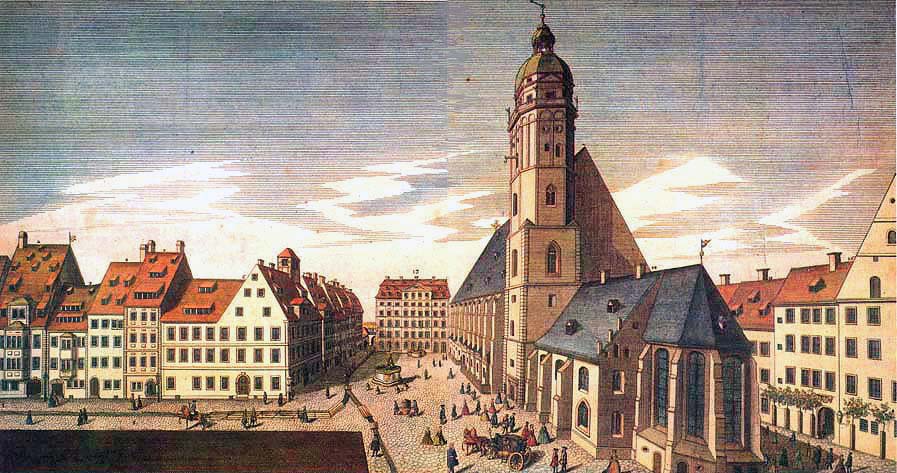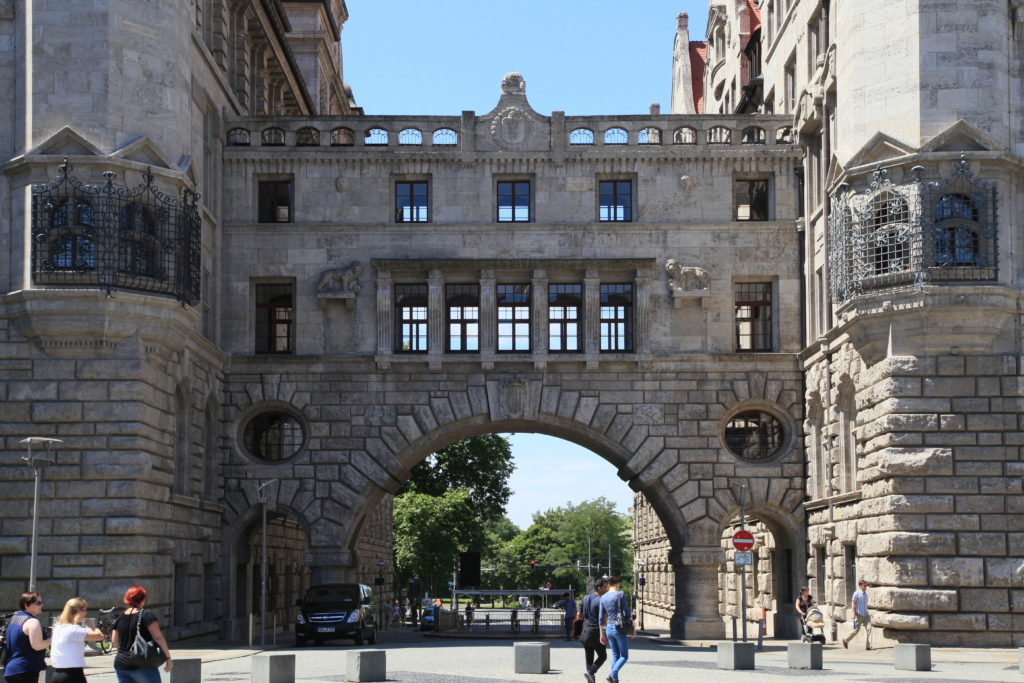
Tomaskirche und Thomasschule zu Leipzig
Leipzig in Musical History
Tony Cooper takes a musical heritage trip to Leipzig
Leipzig is certainly a city rich in musical history. For a start, Richard Wagner was born here. But if Wagner was closely associated with Leipzig so was Felix Bartholdy Mendelssohn and Johann Sebastian Bach, while other notable composers such as Robert Schumann and Georg Philipp Telemann worked in Leipzig and George Frideric Handel was born just a few miles up the road in Halle.
Surprisingly, though, during Bach’s lifetime he was not recognised as the great composer that he is today until a revival of interest in his music was led in the first half of the 19th century by the young Mendelssohn conducting St Matthew Passion at the age of 20 in 1829, the first performance since the composer’s death.
Such was its success that this performance started the Bach ball rolling and, thankfully, it hasn’t stopped. And Leipzig plays its part to the full promoting the music of Bach – who lived and worked in the city from 1723 until his death in 1750 as choirmaster of St Thomas’ Church – in the annual summer BachFest now under the artistic direction of the English baroque master, John Eliot Gardiner. Although the BachFest was only founded in 2000 it has enjoyed a rapid rise to the top echelon of European music festivals. To find out more visit www.bach-festival-leipzig.de
Mendelssohn was a frequent visitor to the British Isles. He was also the first important conductor of the famous Leipzig Gewandhaus Orchestra while in his mid-Twenties and went on to found the Leipzig Conservatoire in his early-Thirties. One of the oldest (and most respected) musical bodies in the world, the Gewandhaus Orchestra is now under the direction of Latvian-born conductor, Andris Nelsons, who was chief conductor of the City of Birmingham Symphony Orchestra from 2007 to 2015.
One of Mendelssohn’s greatest triumphs came by way of Birmingham when their Triennial Festival committee commissioned that momentous and inspiring oratorio, Elijah, composed in the spirit of Mendelssohn’s baroque predecessors, Bach and Handel. The work (his final composition) received its première at Birmingham Town Hall on 26th August 1846, conducted by the composer. It proved to be one of the high points of his illustrious career. He died a year later. Soon afterwards Elijah was heard in Norwich at a Norfolk & Norwich Triennial Festival meeting in St Andrew’s Hall.
In fact, Mendelssohn agreed to write a new oratorio for the 1848 N&N Triennial but death robbed him and Norwich of the commission. There is a touching letter from Mendelssohn to the Festival Committee dated 27/9/1846 in which he says: ‘. . . but if I live and in good health, I’m almost sure that I will have something new by that time.’ He wrote once more in October 1847, just one month before he died.
It is, perhaps, no coincidence to learn that Leipzig and Birmingham are twinned with each other. They gracefully tied the knot in 1992. I visited Mendelssohn’s house at Goldschmidtstraße – now a museum devoted to his life and work and, appropriately, situated just round the corner from the Gewandhaus. He lived here for the last 12 years of his life. I soon set my eyes on Mendelssohn’s piano and thought of the creativity that came from this ‘work-desk’ that is still being enjoyed today by concertgoers the world over. And Mendelssohn’s music salon remains in use today offering a series of morning concerts.
Another aspect of Mendelssohn’s life was as a watercolourist and following a three-month family trip to Switzerland in 1822 at the age of 15 it afforded him a wonderful opportunity to devote himself to this aspect of his creative life. Overall, he completed more than 40 landscapes executed either in watercolour or ink-over-pencil.
Mendelssohn’s correspondence reveals that drawing and painting proved an ideal respite from his compositional duties. On another trip he made to Switzerland in 1838, he wrote to his good friend, Karl Klingemann, with whom he had travelled to Scotland in 1829: ‘I composed not even a bit of music, but rather drew entire days, until my fingers and eyes ached.’
Mendelssohn also relied heavily on drawing as a creative outlet on occasions when he found musical composition impossible such as during the grief-stricken months following his beloved sister Fanny’s unexpected death in May 1847 when he was 38.
Mendelssohn sought consolation from his grief by travelling to Switzerland where he had spent several enjoyable family holidays. On this excursion – which took place in the months preceding his own untimely death in November of the same year as Fanny’s death – Mendelssohn created a series of watercolour landscapes. In the Mendelssohn house one can view a small selection of these lovely pictures including a charming one of Lucerne – one of his favourite Swiss towns.
Another composer closely associated with Leipzig is Robert Schumann. The illuminated and far-sighted Leipzig authorities have an annual festival devoted to him, too, and that of his wife Clara. It takes place next year from 19th to 29th September coinciding (as near as possible) with the Schumann’s wedding. They tied the knot on 12th September 1840 at the Gedächtniskirche in Leipzig Schönefeld – www.schumann-verein.de
Such was Clara’s standing in Leipzig that in 1878 she was honoured at a ceremony in the Gewandhaus to mark her 50th anniversary as a musician. And next year is a special year for Clara – the most famous female musician to be born in Leipzig – as she will be honoured by the city of Leipzig to mark the 200th anniversary of her birth.
The daughter of Friedrich Wieck, an ambitious piano teacher, Clara spent the first 25 years of her life in Leipzig and made her concert début at the age of nine in the Gewandhaus. A highly-acclaimed musician, she successfully toured the Continent giving concerts in such cities as Paris, Vienna, Copenhagen and St Petersburg.
As part of the 200th celebrations visitors can walk in Clara’s footsteps visiting original locations including the Schumann House where she lived for the first four years of her marriage while her compositions will be performed at music venues which have recently been awarded the European Heritage Label.
The extensive programme for the 200th (clara19.leipzig.de) is as diverse as Clara herself. Not only will her compositions take centre stage of the festivities but also her marriage to Robert and her international concert work. Additionally, the festival will focus on her time as a child prodigy, her personal emancipation as well as the conflict she encountered between work and family.
Next year, too, Oper Leipzig will devote a couple of weekends to Richard Strauss (11th-13th January / 26th-28th April) with performances of Der Rosenkavalier, Electra and Salome followed by a Puccini weekend (16th/17th March) featuring Tosca and Turandot plus a Verdi weekend coming up in May (24th-26th) promising exhilarating performances of La traviata, Rigoletto and Nabucco. www.oper-leipzig.de
Wherever you turn in Leipzig you encounter musical history and the city’s famed music trail (Leipziger Notenspur) which links 23 of the most important musical locations in the city along a 5km route is a must. www.notenspur-leipzig.de

Leipzig’s New Town Hall
Tony Cooper is QR’s Opera Critic











Fascinating, Tony – I have never been to Leipzig, but have heard the Gewandhaus Orchestra (at the Proms), with Alfred Brendel.
Years ago, on Radio 3, there was a fascinating series entitled: Bach’s First Christmas at Leipzig. Would be wonderful to hear this again.